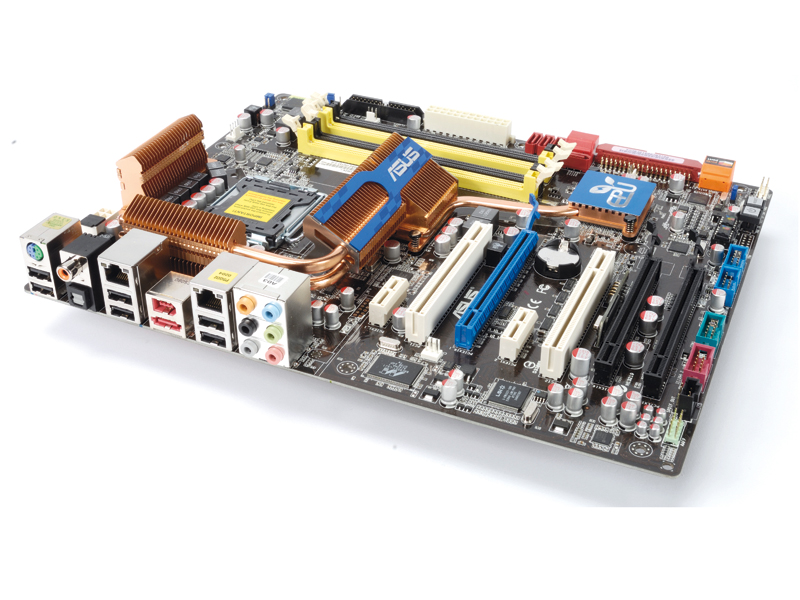TechRadar Verdict
Not a huge step up from the P35, but Asus's innovative take on Intel's new chipset is impressive
Pros
- +
Excellent new features
- +
Decent value for money considering it's new tech
- +
Solid performance
Cons
- -
Not a vast improvement on the P35
Why you can trust TechRadar
Asus has a reputation as one of the more innovative companies in the market - the Eee being a testament to that - and this latest Asus P5Q Deluxe is no exception.
The board itself is well laid-out, with the usual, aesthetically pleasing black PCB. And, strangely, we had no slicing-our-fingers-into-salami problems with the cooling fins as we installed the CPU fan.
One of Asus's more brilliant innovations (actually, forget the Eee) has to be the power and reset buttons built into the motherboard itself - immensely handy for the test-bench overclocker or if you're just having teething problems.
Power-saving features
In addition to the P45 chipset, Asus has crammed its EPU-Six Engine into the P5Q Deluxe. This power-saving system monitors the power draw of the processor, graphics card, memory, chipset hard drives and CPU fan, and adjusts them automatically for different application environments.
So if you're simply browsing the net it switches to Energy-Saving mode, but when you boot up Crysis it will go into Turbo mode. The settings can be adjusted on the fly, and it even tells you how many milligrams of carbon monoxide you aren't pumping into the atmosphere. Asus claims it can significantly save on electricity bills, which is likely to please some polar bears.
On top of the power-saving features, Asus has incorporated its Splashtop Instant-On operating system into the motherboard. One of those "why did no one think of this before?" ideas, the Splashtop is a bespoke Linux installation that enables access to the internet via a customised version of Firefox, chat with Skype and a basic photo browser.
Sign up for breaking news, reviews, opinion, top tech deals, and more.
It's quite underpowered, but when you're desperate for a quick map or cinema times it's immeasurably handy. It's also getting rolled out across its entire mobo range, stored on a chip at the high-end and offering HD installation via support CD on the rest.
Handy software
The Splashtop software is built onto the motherboard in the Deluxe.
With its own dedicated 512MB of RAM there's no need to worry about not being able to get on the net when you fry your hard disk. Asus is also touting this as an energy-saving feature, as users will be less likely to leave their PCs running if they know the web will boot in a matter of seconds.
Although it's a great bit of software, it still needs a little polish - it failed to detect our Microsoft mouse (conspiracy alert!) and we were left tabbing around the various menus. A BIOS update should fix that, and given time we could see an evolved version of Splashtop revolutionise the way we use PCs.
Underwhelming performance
So energy-saving and innovation in one, but how does the P45 platform perform?
We tested it against Intel's P35 and X38 chipsets, as well as Nvidia's 790i chipset, and performance was surprisingly underwhelming. It's not that it's bad, it's just unimpressive. The biggest surprise here is that the P35 outperformed the P45 slightly on RAM and processor tests - although this could be down to early driver issues. But impressively for a board at this price, 3D performance was in fact only slightly behind ASUS's holier-than-though but hideously expensive 790i-based Striker II. And that's without any overclocking.
When compared to the X38 we noticed significant improvements across the (ahem) board, which is shocking when you consider that Intel was touting it as a high-end chipset barely a year ago. Even the P35 managed to outdo the X38. Hopefully the Nehalem won't go through so many mind-bogglingly pointless iterations, but that does seem to be Intel's penchant du jour.
Worth the upgrade?
It's also worth bearing in mind that although the P45 chipset supports DDR3 RAM, the P5Q Deluxe only supports DDR2.
All motherboard manufacturers have released their P45 boards in a range from stripped-down budget to fully-featured expensive, and the P5Q Deluxe sits more towards the value end of the spectrum, so no DDR3 for us. Although given the ludicrous prices and minimal performance gain from DDR3, it hardly seems worth it.
If you've got a P35-based board it's probably not worth upgrading at present. But if you've got anything less, and you're after a solid, competent motherboard with lots of handy features, the P5Q Deluxe is undoubtedly worth considering.
The TechRadar hive mind. The Megazord. The Voltron. When our powers combine, we become 'TECHRADAR TEAM'. You'll usually see this author name when the entire team has collaborated on a project or an article, whether that's a run-down ranking of our favorite Marvel films, or a round-up of all the coolest things we've collectively seen at annual tech shows like CES and MWC. We are one.
